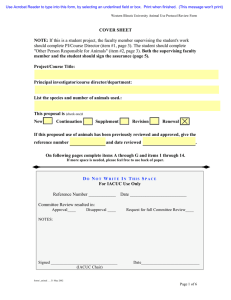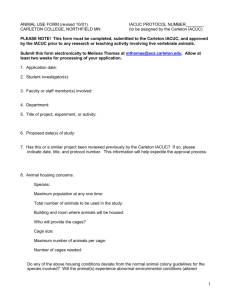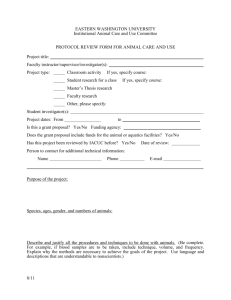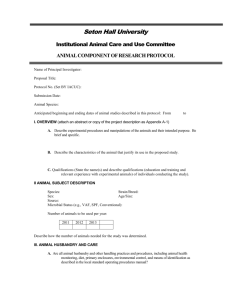DePaul University FOR IACUC USE ONLY Institutional Animal Care
advertisement
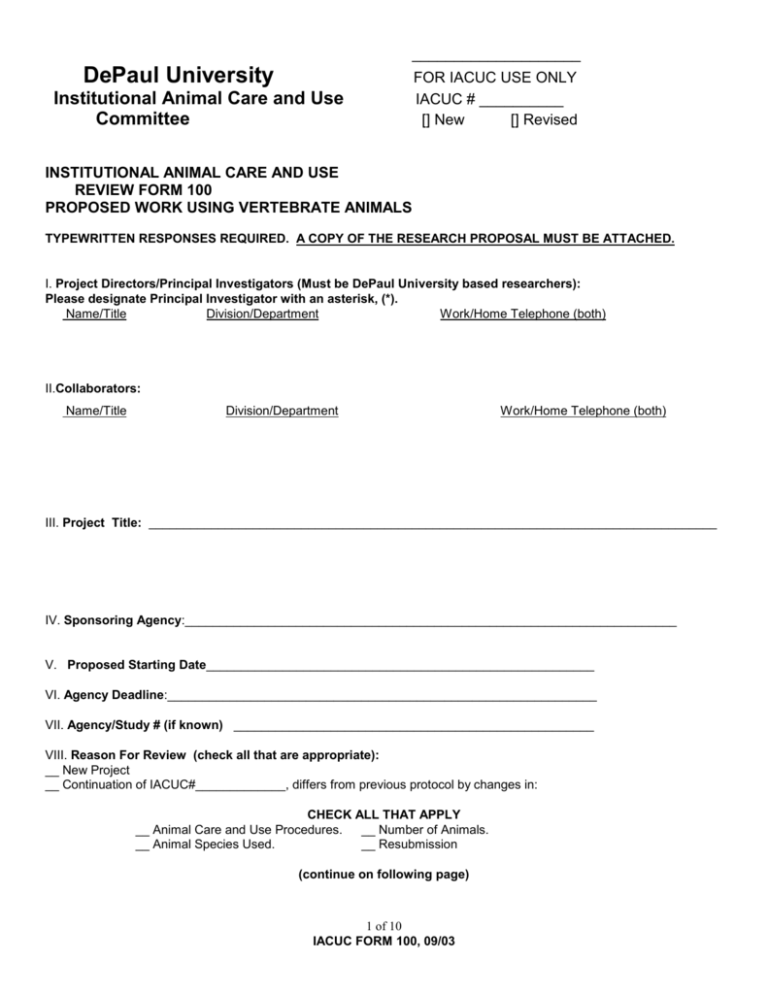
____________________ DePaul University Institutional Animal Care and Use Committee FOR IACUC USE ONLY IACUC # __________ [] New [] Revised INSTITUTIONAL ANIMAL CARE AND USE REVIEW FORM 100 PROPOSED WORK USING VERTEBRATE ANIMALS TYPEWRITTEN RESPONSES REQUIRED. A COPY OF THE RESEARCH PROPOSAL MUST BE ATTACHED. I. Project Directors/Principal Investigators (Must be DePaul University based researchers): Please designate Principal Investigator with an asterisk, (*). Name/Title Division/Department Work/Home Telephone (both) II.Collaborators: Name/Title Division/Department Work/Home Telephone (both) III. Project Title: __________________________________________________________________________________ IV. Sponsoring Agency:_______________________________________________________________________ V. Proposed Starting Date________________________________________________________ VI. Agency Deadline:______________________________________________________________ VII. Agency/Study # (if known) ____________________________________________________ VIII. Reason For Review (check all that are appropriate): __ New Project __ Continuation of IACUC#_____________, differs from previous protocol by changes in: CHECK ALL THAT APPLY __ Animal Care and Use Procedures. __ Number of Animals. __ Animal Species Used. __ Resubmission (continue on following page) 1 of 10 IACUC FORM 100, 09/03 IX. NON-TECHNICAL SUMMARY. Briefly state scientific aims, objectives and methods of this project. Indicate the probable benefits of this work to human health, the advancement of knowledge, or the good of society. This section must be written in lay language, (i.e.: language found in the newspaper). DO NOT EXCEED THIS PAGE. X. ANIMALS PROPOSED FOR USE lN THE PROJECT. List specifications, where known, in the appropriate spaces. In "Health Status" box, indicate conventional animals, virus-antibody free animals, germ-free animals, etc. #1 #2 #3 SPECIES BREED/STRAIN VENDOR/SOURCE WEIGHT/RANGE AGE RANGE SEX TOTAL ANIMALS (THIS YEAR ONLY) MAXIMUM # ON HAND AT ONCE AVERAGE DAYS EACH KEPT HEALTH STATUS Xl. SPECIAL REVIEW ITEMS: Indicate which of the following review considerations apply to the proposed project. For each question, indicate a YES answer by marking the appropriate space for each species. Do the proposed experiments require: Species # (from X above) A. Prolonged restraint of awake animals (> 3 hours)? #1 __ #2 __ #3 __ A. B. Prolonged food or water deprivation (other than overnight preoperative fast [>12 hours])? __ __ __ B. C. Potentially painful procedure performed without anesthetic? __ __ __ C. D. More than one major surgical procedure on the same animal? __ __ __ D. E. Administration of paralytic agents or muscle relaxants? __ __ __ E. F. Unrelieved postprocedural pain, distress or functional deficit? __ __ __ F. G. Procedures requiring death other than euthanasia as an endpoint (e.g. LD-50 testing)? __ __ __ G. H. Method of euthanasia not approved by the AVMA Panel on Euthanasia? __ __ __ H. I. Administration of complete Freund's adjuvant? __ __ __ I. J. Antibody production using Pristane? __ __ __ J. __ __ __ K. K. Animals kept in your laboratory for 12 hours or more? L. For every item checked above, follow instructions on the next page. Federal laws and regulations require that special attention be paid to some animal care and use procedures. Please provide clear justification, on scientific grounds, in the space below for any of the items that are checked on the previous page, section XI. Label each response appropriately (e.g. If D is checked for Species #2, preface the response as XI.D.2.). Use additional pages as necessary, numbering as 4a, 4b, etc. XII. NON-STANDARD ANIMAL CARE. Indicate below for which animal species non-standard housing conditions or care are required. Check the appropriate boxes for the animal species listed in item X, (Page 4) to which non-standard conditions apply. #1 #2 #3 A. Non-standard animal room conditions (e.g. temperature, humidity, lighting). __ __ __ A. B. Non-standard animal cages or pens. __ __ __ B. C. Non-standard animal care routines. Examples: methods or schedules of feeding. watering, cage cleaning, bedding type or changing schedule. __ Disease barrier housing or procedures required to protect animals from naturally occurring animal infections. (e.g., housing for nude mice). __ Hazard containment housing or procedures. Special measures to reduce exposure of personnel or other animals to hazardous substances. This includes, but is not limited to radioactive materials, infectious agents, carcinogenic or toxic chemicals, biologically active steroids. __ __ __ C. __ __ D. __ __ E. D. E. Name of hazardous substances OR infectious agents: For Species # 1:____________________________ For Species # 2: ___________________________ For Species # 3: ___________________________ Explain below the details of the non-standard housing conditions required for each item marked above. Include a separate description for each species for which such conditions is required. Continue on additional pages if necessary. Number pages appropriately (i.e., Page 5a. 5b). If hazardous material is used, describe safety measures to be taken and disposal conditions to be used. XIII. ANIMAL USE PROTOCOLS. For each species and/or model: DESCRIBE lN DETAIL all procedures in the order in which they will be performed. Indicate where procedures are to be performed. Use additional pages if necessary. Number pages appropriately (i.e., Page 6a, 6b). THE INFORMATION LISTED BELOW (A-E) MUST BE INCLUDED IN THE DESCRIPTION OF THE DESCRIPTION OF PROCEDURES, IF APPLICABLE: A. If any surgical procedures are to be performed from which an animal is expected to recover, describe the measures taken to prevent wound infection in presurgical preparation, during surgery and for wound hygiene following surgery. B. If any surgical or non-surgical manipulation involves postprocedural pain or distress. Describe how pain will be recognized and with what frequency the animals are to be monitored to assure recovery from anesthesia and well-being during convalescence. Describe procedures for euthanasia in case of excess pain or distress during convalescence. Post procedural analysis with specific dosages is required unless scientifically justified. If euthanasia is to be withheld in such cases, explain why. C. Note any anticipated impaired function in the animal's ability to breath, ambulate, drink, eat, eliminate, and otherwise maintain itself, and the expected duration of these conditions. D. State what records are to be maintained to document that presurgical and post surgical care by laboratory workers was provided in accordance with established veterinary medical and nursing procedures. E. If procedures involve implanted devices, describe their implantation and daily care or monitoring. F. State method of disposition of animals and tissues upon completion of experiment or completion of their use. XlV. ANESTHETIC SUMMARY. Summarize agent(s) (anesthetics, analgesics and tranquilizers) to be used to alleviate pain and distress in the animals during and after the procedure. Specify doses, routes, and frequency of administrations. Species Name Agent # Agent Dose Route (mg/kg) Frequency Combined w/Agent # 1 2 3 4 5 6 7 8 XV. EUTHANASIA METHODS. Summarize methods of euthanasia. Include doses and routes of administration for drugs to be used. How will the animals be monitored to assure that death has occurred? Indicate by marking yes or no if the method is approved for use by the AVMA. Species Name Method and Route Dose (mg/kg) AVMA Approved Method of Assurance The following information is required for DePaul to fulfill its obligations under current U.S. Public Health Service Policy and the U.S. Department of Agriculture's Animal Welfare Act regulations. XVI. JUDICIOUS USE OF ANIMALS. Answer all questions using non-technical language. Use additional pages as necessary. Label each page appropriately (Page 8a, 8b, etc.) A. Justify the species and number of animals to be used in this experiment, including the method of statistical validation. Include a description of previous experience in the use of the proposed animal model and protocol. B. Describe your previous experience with the proposed animal model. C. Explain why mathematical or computer models, in vitro systems, or human studies cannot serve as alternatives to the use of animals in this project. D. If procedures that may cause more than momentary or slight pain or distress to the animals are used, provide a written narrative description of the methods and sources used to determine that alternatives are not available. For example, if an electronic literature search is used, please list the key words searched. XVII. PERSONNEL: List all personnel who will perform or supervise any animal-related procedures for this project. Name Position/Department Phone # work/home Trained? Work: Home: Work: Home: Work: Home: Work: Home: Work: Home: Work: Home: Work: Home: Work: Home: * It is a federal requirement that all personnel involved in supervising or who will perform animal care, treatment, and use be qualified to perform their duties. These individuals should have completed DePaul's Animal Care and Use Training Program for the species being used. XVIII. ANIMAL COSTS (FOR NEW APPLICATIONS: FIRST 12 MONTHS ONLY) (FOR CONTINUATIONS: CONTINUATION YEAR ONLY) PURCHASE OF ANIMALS Species/Strain Total Number of Animals TOTAL PURCHASE COSTS: Cost Per Animal ANIMAL CARE PER DIEM COSTS Estimated Cost Maximum Daily Census Count $ TOTAL PER DIEM COSTS: Estimated Total Animal Days Per Diem Per Animal Estimated Cost $ XIX. PROJECT DIRECTOR/PRINCIPAL INVESTIGATOR(S) ASSURANCES: A. I acknowledge responsibility for this project. B. I agree not to undertake any aspect of this project until I have received written approval from the IACUC. C. I agree to comply with all Federal, State and University animal welfare laws and policies in the performance of this project. D. I assume the responsibility for ensuring that all persons working in my laboratory and/or on this project will be trained in accordance with University policy and will comply with all applicable laws and policies. E. I am aware that if this project is altered, a new Animal Care and Use Form 100 or 200 must be completed and submitted to the IACUC. F. I certify that the activities described in this proposal, to the best of my knowledge, do not unnecessarily duplicate previous experiments. G. I certify that the statements made in this form are true and complete to the best of my knowledge. Signature of the Project Director/ Principal Investigator_______________________________________ Date___________________

